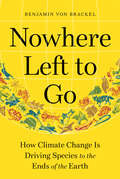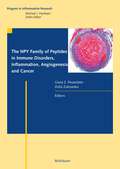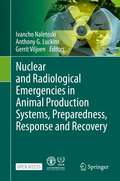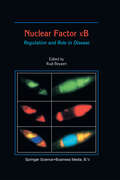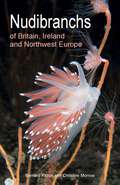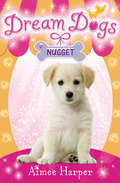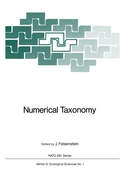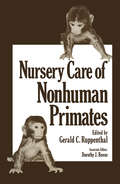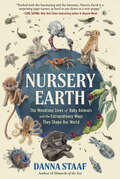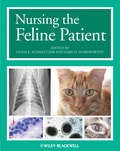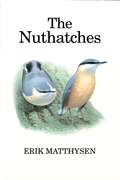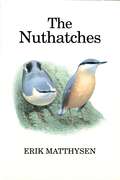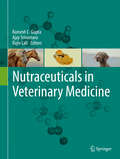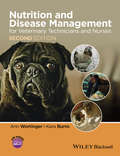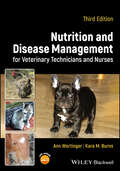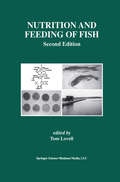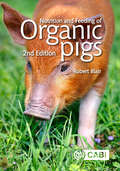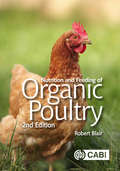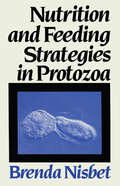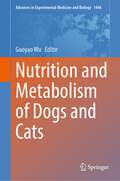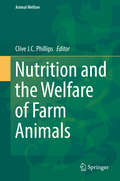- Table View
- List View
Nowhere Left to Go: How Climate Change Is Driving Species to the Ends of the Earth
by Benjamin von BrackelHarrowing journeys of animals and plants—fleeing skyrocketing temperatures and mega-droughts—reported from the front lines of the biggest migration of species since the Ice Age
The NPY Family of Peptides in Immune Disorders, Inflammation, Angiogenesis, and Cancer (Progress in Inflammation Research)
by Zofia Zukowska Giora Z. FeuersteinRecent research indicates that the immune system and inflammatory reactions are governed and regulated by powerful neuronal mediators derived from the central and peripheral nervous system. The NPY family of peptides is a diverse group of neuropeptides that acts via multiple receptors, Y1-Y5, which are widespread not only in neurons but also in a variety of non-neural and immune cells. These peptides have been known as important regulators of many essential systems, such as blood pressure and cardiac function, food consumption and energy homeostasis. However, in recent years, they have also become recognized for their role as potent modulators of cell growth and immune functions with broad implications in chronic inflammatory diseases, cancer and angiogenesis.In this book, experts in the field analyze recent evidence supporting the role of NPY family of peptides in regulation of the immune/inflammatory system with special reference to its medical and therapeutic implications.
Nuclear and Radiological Emergencies in Animal Production Systems, Preparedness, Response and Recovery
by Gerrit Viljoen Ivancho Naletoski Anthony G. LuckinsThis Open Access volume explains how major nuclear and radiological emergencies (NREs) can have implications at local, national and international level. The response to NREs requires a competent decision-making structure, clear communication and effective information exchange. National veterinary services have the responsibility to plan, design and manage animal production system in their countries. These activities cover animal health, animal movement control, production control and improvement, and control of the products of animal origin before their placement on the market. Release of radionuclides after NREs can cause substantial contamination in the animal production systems. Critical responsibility of veterinary authorities is therefore to prevent such contamination, establish early response mechanisms to mitigate the consequences and prevent placement of contaminated products of animal origin on the market for human consumption. This work summarizes the critical technical points for effective management of NREs for national veterinary services.
Nuclear Factor кB: Regulation and Role in Disease
by R. BeyaertSeventeen years after its initial description, nuclear factor-KB (NF-KB) endures as one of the most studied transcription factors. NF-KB has attracted widespread interest based on the variety of stimuli that activate it, the diverse genes and bio logical responses that it controls, the striking evolutionary conservation of struc ture and function among species, and its involvement in a variety of human diseases. The biochemical basis by which several stimuli converge to activate NF-KB has been largely elucidated during recent years. While first discovered as a key regulatory factor of the immune system, NF-KB is now recognized as an important player in the functioning of many organs and cell types. The ongoing examination of NF-KB signaling has revealed its ever expanding role in immune and inflammatory responses, but also in cancer and development. For this reason, numerous efforts are underway to develop safe inhibitors of NF-KB to be used in the treatment of both chronic and acute disease situations. The present book is the first to review and synthesize our knowledge of this interesting transcription factor. As such, the choice of subjects to review was daunting. To set the stage, an introductory chapter on activators and target genes, as well as the role they play in several responses, has been included.
Nudibranchs of Britain, Ireland and Northwest Europe: Second Edition
by Bernard Picton Christine MorrowA strikingly illustrated photographic identification guide to sea slugs in all their colourful varietyNudibranchs, or sea slugs, are a group of marine gastropod molluscs whose adults lack shells, an evolutionary loss that has led to a wide variety of body shapes, colours and colour patterns, making them popular with divers and underwater photographers. In this book, experienced nudibranch experts Bernard Picton and Christine Morrow provide an accessible and authoritative photographic identification guide for anyone interested in finding and identifying nudibranchs in the coastal waters of Britain, Ireland and Northwest Europe.Covers more than 195 species, each on its own two-page spreadIncludes in situ photos to aid finding nudibranchs under water and on the shoreFeatures photos of nudibranchs’ distinctive spawn coils and studio photos showing detailed anatomyPresents key distinguishing features and essential information on size, habitat, diet and distribution
Nugget (Dream Dogs #3)
by Aimee HarperThe third exciting adventure from the animal series set in a glamorous pooch parlour, for animal-crazy girls who love dogs and looking after them.
Numerical Taxonomy (Nato ASI Subseries G: #1)
by Joseph FelsensteinThe NATO Advanced Study Institute on Numerical Taxonomy took place on the 4th - 16th of July, 1982, at the Kur- und Kongresshotel Residenz in Bad Windsheim, Federal Republic of Germany. This volume is the proceedings of that meeting, and contains papers by over two-thirds of the participants in the Institute. Numerical taxonomy has been attracting increased attention from systematists and evolutionary biologists. It is an area which has been marked by debate and conflict, sometimes bitter. Happily, this meeting took place in an atmosphere of "GemUtlichkeit", though scarcely of unanimity. I believe that these papers will show that there is an increased understanding by each taxonomic school of each others' positions. This augurs a period in which the debates become more concrete and specific. Let us hope that they take place in a scientific atmosphere which has occasionally been lacking in the past. Since the order of presentation of papers in the meeting was affected by time constraints, I have taken the liberty of rearranging them into a more coherent subject ordering. The first group of papers, taken from the opening and closing days of the meeting, debate philosophies of classification. The next two sections have papers on congruence, clustering and ordination. A notable concern of these participants is the comparison and testing of classifications. This has been missing from many previous discussions of numerical classification.
Nursery Care of Nonhuman Primates (Advances in Primatology)
by G. C. RuppenthalThe Infant Primate Research Laboratory at the University of Washington was conceived in 1970 as a small research Wlit primarily for support of two individual's interests in early develop ment of nonhuman primates. Because of their research emphasis, a modest nursery was required to support a small population of animals for specific experimental studies. The laboratory experi enced rapid growth when others at the University became interested in the use of monkeys as models for early development and mental retardation in humans. In 1972 the Wlit was formally established as a core facility of the Child Development and Mental Retardation Center and the Regional Primate Research Center. This joint administrative and financial support allowed us to invest considerable effort in the development of normative data for rearing animals in our nursery as well as for identifying, documenting, and rearing subjects at high risk for neonatal death. As part of that effort, every attempt has been made to promote a multidisciplinary approach to ques tions associated with rearing nonhuman primates. This volume includes much of the information thus gathered. I feel that such an approach is essential to the promotion of scientific principles in rearing and has allowed the laboratory to contribute to prima tology.
Nursery Earth: The Wondrous Lives of Baby Animals and the Extraordinary Ways They Shape Our World
by Danna StaafFrom the author of Monarchs of the Sea, a first-of-its-kind journey into the hidden world of baby animals—hailed as &“a gobsmacking delight!&” (Sy Montgomery, New York Times–bestselling author of The Soul of an Octopus) It&’s time to pay attention to baby animals. From egg to tadpole, chick to fledgling, they offer scientists a window into questions of immense importance: How do genes influence health? Which environmental factors support—or obstruct—life? Entire ecosystems rest on the shoulders (or tentacles, or jointed exoskeletons) of animal babies. At any given moment, babies represent the majority of animal life on Earth. In Nursery Earth, researcher Danna Staaf invites readers into the sibling (and, sometimes, clashing) fields of ecology and developmental biology. The tiny, hidden lives that these scientists study in the lab and in the wild reveal some of nature&’s strangest workings: A salamander embryo breathes with the help of algae inside its cells. The young grub of a Goliath beetle dwarfs its parents. The spotted beak of a parasitic baby bird tricks adults of other species into feeding it. Mouse embryos can absorb cancerous cell grafts—and develop into healthy adults. Our bias toward adult animals (not least because babies can be hard to find) means these wonders have long gone under-researched. But for all kinds of animals, if we overlook their babies, we miss out on the most fascinating—and consequential—time in the lives of their species. Nursery Earth makes the case that these young creatures are not just beings in progress but beings in their own right. And our planet needs them all: the maggots as much as the kittens!
Nursery Rearing of Nonhuman Primates in the 21st Century (Developments in Primatology: Progress and Prospects)
by Gene P. Sackett Gerald Ruppenthal Kate EliasNursery Rearing of Nonhuman Primates in the 21st Century describes how and why nursery rearing of primates can produce adaptable juveniles and adults for research, conservation, and display-educational purposes. The volume details the history of nursery rearing since the mid-19th century, the outcomes of varied nursery rearing methods, the contemporary goals of nursery rearing as well as reference data derived from species commonly reared in nursery or hand-feeding situations. Examples of the changing goals of nursery rearing covered in this volume are the need for biological containment in disease research, the production of specific pathogen-free colonies by removal of neonates from the mother, the production of phenotypes for genetic and molecular biology studies, and the breeding of endangered species for conservation or research purposes.
Nursing the Feline Patient
by Linda E. SchmeltzerNursing the Feline Patient is a comprehensive and accessible clinical manual addressing the unique nursing needs of cats. Covering all aspects of feline nursing care from the examination room to the surgical suite, the book highlights the special considerations for cat patients throughout. Written specifically for veterinary technicians and nurses, topics range from restraint, preventative care, and laboratory procedures to surgery, dentistry, and specific diseases of concern. Carefully designed for easy reference, chapters are logically organized into sections on patient management, diagnostics, surgery and recovery, and major diseases by body system. Each chapter begins with an overview of the anatomy and physiology required for a full understanding of the disease. Nursing the Feline Patient is an essential resource for veterinary technicians working with feline patients.
Nursing the Feline Patient
by Linda E. Schmeltzer Gary D. NorsworthyNursing the Feline Patient is a comprehensive and accessible clinical manual addressing the unique nursing needs of cats. Covering all aspects of feline nursing care from the examination room to the surgical suite, the book highlights the special considerations for cat patients throughout. Written specifically for veterinary technicians and nurses, topics range from restraint, preventative care, and laboratory procedures to surgery, dentistry, and specific diseases of concern. Carefully designed for easy reference, chapters are logically organized into sections on patient management, diagnostics, surgery and recovery, and major diseases by body system. Each chapter begins with an overview of the anatomy and physiology required for a full understanding of the disease. Nursing the Feline Patient is an essential resource for veterinary technicians working with feline patients.
The Nuthatches (Poyser Monographs #131)
by Erik Matthysen David QuinnThe Nuthatches is based on the European Nuthatch, with comparative information on the other west Paleartic and world species. Comparisons with other nuthatch species provide general perspectives on biological species separation problems. Features: * Comparative information on the other west Paleartic and world species * Provides general perspectives on biological species separation problems
The Nuthatches (Poyser Monographs #46)
by Erik Matthysen David QuinnThe Nuthatches is based on the European Nuthatch, with comparative information on the other west Paleartic and world species. Comparisons with other nuthatch species provide general perspectives on biological species separation problems. Features: * Comparative information on the other west Paleartic and world species * Provides general perspectives on biological species separation problems
Nutraceuticals in Veterinary Medicine
by Ramesh C. Gupta Ajay Srivastava Rajiv LallThis unique work compiles the latest knowledge around veterinary nutraceuticals, commonly referred to as dietary supplements, from ingredients to final products in a single source. More than sixty chapters organized in seven sections collate all related aspects of nutraceutical research in animal health and disease, among them many novel topics: common nutraceutical ingredients (Section-I), prebiotics, probiotics, synbiotics, enzymes and antibacterial alternatives (Section-II), applications of nutraceuticals in prevention and treatment of various diseases such as arthritis, periodontitis, diabetes, cognitive dysfunctions, mastitis, wounds, immune disorders, and cancer (Section-III), utilization of nutraceuticals in specific animal species (Section-IV), safety and toxicity evaluation of nutraceuticals and functional foods (Section-V), recent trends in nutraceutical research and product development (Section-VI), as well as regulatory aspects for nutraceuticals (Section-VII). The future of nutraceuticals and functional foods in veterinary medicine seems bright, as novel nutraceuticals will emerge and new uses of old agents will be discovered. International contributors to this book cover a variety of specialties in veterinary medicine, pharmacology, pharmacognosy, toxicology, chemistry, medicinal chemistry, biochemistry, physiology, nutrition, drug development, regulatory frameworks, and the nutraceutical industry. This is a highly informative and carefully presented book, providing scientific insight for academia, veterinarians, governmental and regulatory agencies with an interest in animal nutrition, complementary veterinary medicine, nutraceutical product development and research.
Nutrition and Disease Management for Veterinary Technicians and Nurses
by Ann Wortinger Kara BurnsNutrition and Disease Management for Veterinary Technicians and Nurses, Second Edition offers a thorough update and significant expansion of this easy-to-use introduction to veterinary nutrition and diet, with broader species coverage, a new section on nutritional management of disease, and many new chapters. • Provides a complete reference to veterinary nutrition, from the fundamentals to feeding companion animals of any age and health status • Adds information on nutrition in birds, small mammals, and horses to the existing dog and cat coverage • • Presents a new section on managing disease through nutrition, with 10 new disease chapters • Offers additional new chapters on nutritional calculations, types of pet foods, raw food diets, additives and preservatives, nutrition myths, nutritional support, and assisted feeding • Includes access to a companion website with case studies, review questions and answers, and the figures from the book in PowerPoint
Nutrition and Disease Management for Veterinary Technicians and Nurses
by Ann Wortinger Kara BurnsNutrition and Disease Management for Veterinary Technicians and Nurses, Second Edition offers a thorough update and significant expansion of this easy-to-use introduction to veterinary nutrition and diet, with broader species coverage, a new section on nutritional management of disease, and many new chapters. • Provides a complete reference to veterinary nutrition, from the fundamentals to feeding companion animals of any age and health status • Adds information on nutrition in birds, small mammals, and horses to the existing dog and cat coverage • • Presents a new section on managing disease through nutrition, with 10 new disease chapters • Offers additional new chapters on nutritional calculations, types of pet foods, raw food diets, additives and preservatives, nutrition myths, nutritional support, and assisted feeding • Includes access to a companion website with case studies, review questions and answers, and the figures from the book in PowerPoint
Nutrition and Disease Management for Veterinary Technicians and Nurses
by Ann Wortinger Kara M. BurnsNutrition and Disease Management for Veterinary Technicians and Nurses A fully updated edition of the student-friendly guide to veterinary nutrition Diet and nutrition are essential aspects of veterinary care. Proper care and feeding of companion animals can improve health outcomes and help to prevent disease. Meeting the altered dietary needs of a sick animal can facilitate recovery and improve quality of life. For veterinary technicians, nurses, and other veterinary practitioners, a working knowledge of companion animal nutrition is an essential component of overall patient care. Nutrition and Disease Management for Veterinary Technicians and Nurses offers an accessible, up-to-date introduction to the key concepts and elements of veterinary nutrition. With detailed coverage of the fundamentals of veterinary nutrition in addition to the nutritional management for many common small animal diseases, the third edition incorporates all the essentials of veterinary nutrition and dietary management for veterinary patients of any age or health status. Readers of the third edition of Nutrition and Disease Management for Veterinary Technicians and Nurses will also find: Fourteen new chapters, plus additional species in some chapters An added section on prebiotics, probiotics, and synbiotics End-of-chapter summaries with multiple-choice questions and case reviews to facilitate use in the classroom Nutrition and Disease Management for Veterinary Technicians and Nurses is ideal for all veterinary technician students, working veterinary technicians, nurses, and students working towards specialty certification in veterinary nutrition.
Nutrition and Disease Management for Veterinary Technicians and Nurses
by Ann Wortinger Kara M. BurnsNutrition and Disease Management for Veterinary Technicians and Nurses A fully updated edition of the student-friendly guide to veterinary nutrition Diet and nutrition are essential aspects of veterinary care. Proper care and feeding of companion animals can improve health outcomes and help to prevent disease. Meeting the altered dietary needs of a sick animal can facilitate recovery and improve quality of life. For veterinary technicians, nurses, and other veterinary practitioners, a working knowledge of companion animal nutrition is an essential component of overall patient care. Nutrition and Disease Management for Veterinary Technicians and Nurses offers an accessible, up-to-date introduction to the key concepts and elements of veterinary nutrition. With detailed coverage of the fundamentals of veterinary nutrition in addition to the nutritional management for many common small animal diseases, the third edition incorporates all the essentials of veterinary nutrition and dietary management for veterinary patients of any age or health status. Readers of the third edition of Nutrition and Disease Management for Veterinary Technicians and Nurses will also find: Fourteen new chapters, plus additional species in some chapters An added section on prebiotics, probiotics, and synbiotics End-of-chapter summaries with multiple-choice questions and case reviews to facilitate use in the classroom Nutrition and Disease Management for Veterinary Technicians and Nurses is ideal for all veterinary technician students, working veterinary technicians, nurses, and students working towards specialty certification in veterinary nutrition.
Nutrition and Feeding of Fish
by Tom LovellAquaculture is now recognized as a viable and profitable enterprise worldwide. As aquaculture technology has evolved, the push toward higher yields and faster growth has involved the enhancement or replacement of natural foods with prepared diets. In many aquaculture operations today, feed accounts for more than one-half the variable operating cost. Therefore, knowledge of nutrition and practical feeding of fish is essential to successful aquaculture. This book is not written exclusively for scientists but also for students, practicing nutritionists, and aquaculturists. It covers the known nutrient requirements and deficiency effects for different fishes, and digestion and metabolism of nutrients and energy. It discusses nutrient sources and preparation of practical and research feeds. It gives directions for conducting fish nutrition and feeding experiments. Feeding practices for salmonids, channel catfish, tilapias, shrimps and hybrid striped bass are presented. Since the first edition of this book was printed, the National Research Council of the National Academy of Sciences has revised the nutrient requirements for fish. These revisions are in the present edition. Other additions to this revised edition are chapters on nutrition and fish health, and bioavailability of nutrients. Each original chapter has been meticulously revised and updated with new information. Aquaculture is a dynamic area and new technologies are being introduced continuously; therefore, some of the material discussed in this revised edition may become obsolete quickly. Nonetheless, the material presented has been thoughtfully selected and updated to make it of maximum use to persons whose interests range from general aquaculture to animal nutrition to feed manufacture.
Nutrition and Feeding of Organic Pigs
by Robert BlairOrganic animal production has increased rapidly in recent years to keep up with the increasing consumer demand for organic meats. There are many guidelines and restrictions on what should go into the feedstuffs of organically farmed animals, from which difficulties arise when trying to ensure a well-balanced, nutritious diet without the use of any supplements. This second edition of Robert Blair's classic and bestselling book on the nutrition and feeding of organic pigs presents comprehensive advice that includes: - formulating appropriate diets and integrating them into organic pig production systems; - international standards of organic feeding; - feed-related disease incidence in organic herds. The book has been completely updated and revised to address how to formulate organic diets in situations where there is a declining supply of organic feed, as well as the feasibility of utilizing novel feedstuffs and their acceptability by consumers of organic meat products. Including the experiences of producers in relation to appropriate breeds and production systems for forage-based organic production, this book is an important read for researchers and students of organic food animal production, veterinary sciences and food; as well as food industry personnel and organic farmers.
Nutrition and Feeding of Organic Poultry
by Robert BlairOrganic poultry production has increased significantly in recent years to keep up with increasing consumer demand for organic eggs and meat. There are many guidelines and restrictions on what should go into the feed of organically-farmed poultry, from which difficulties arise when trying to ensure a well-balanced nutritious diet without the use of any unapproved supplements. This, the second edition of Robert Blair's classic and bestselling book on the nutrition and feeding of organic poultry, presents advice for organic producers, and the agencies and organizations serving them. It covers: - Selecting suitable ingredients. - Preparing appropriate feed mixtures and integrating them into organic poultry production systems. - International standards for organic feeding. - Breeds that are most suitable for organic farming. - Examples of diets formulated to organic standards. Completely updated and revised to address how to formulate organic diets in situations where there is a declining supply of organic feed, this new edition also includes up-to-date information on the nutritional requirements of poultry and feed-related disease incidence in organic flocks. Also including the feasibility of utilizing novel feed, such as insect meal, and their acceptability by consumers of organic meat products, this book forms a comprehensive reference for students, organic farmers, veterinarians and researchers.
Nutrition and Feeding Strategies in Protozoa
by Brenda Nisbet1 Modern biologists describe protozoa as microscopic eukaryotic organ isms with a capacity for establishing themselves in almost every con ceivable habitat provided it contains moisture in some form. In 1674 at the time when Antony von Leeuwenhoek was making his first observations of 'very small animalcules' in Berkelse Mere near his home town of Delft, this concept of the ubiquity of protozoa would have been difficult to comprehend. Leeuwenhoek's curiosity later led him to examine the body fluids, gut contents and excreta of different animals and to describe 'an inconceivably great company of living animalcules, and these of divers sorts and sizes'. Here were early des criptions of parasitic protozoa, species which later came to be recog nized as Opalina, Giardia, Trichomonas and others. Following his pioneering work in the field of microscopic observation, knowledge of protozoa has accumulated at an accelerating pace. Some 30,000 living species have been identified, and an equal number of fossil species, from habitats which range from the ocean waters to the exuvial fluid of insects. The study of protozoan nutrition is a particularly interesting aspect of this expanding field of zoology. What kind of nourishment do protozoa need, how do they acqlire it, and what influence do the answers to these two questions havE on where protozoa live? The need to determine what hId of food protozoa are utilizing in their environment is desirable in al ecological studies involving micro organisms of aquatic communities.
Nutrition and Metabolism of Dogs and Cats (Advances in Experimental Medicine and Biology #1446)
by Guoyao WuThis book provides new knowledge about the nutrition and metabolism, as well as the roles of nutrients in the immunity, health, and management of companion animals (dogs and cats). The domestic dog (facultative carnivore) and the domestic cat (obligate carnivore) have evolved differentially in their digestive tract, nutrition, metabolism, chemical sensing, and feeding behavior. These animals have been human companions for at least 12,000 and 9,000 years, respectively, and continue to contribute to the mental health and well-being of children, adolescents, and adults. Both dogs and cats have become increasingly popular in many countries and worldwide over the past decades. Comprehensive update about how the animals utilize dietary nutrients for optimum growth, development, and health is beneficial for their owners, as well as students and researchers. Chapter 4: Characteristics of Nutrition and Metabolism in Dogs and Cats is available open access under a Creative Commons Attribution 4.0 International License
Nutrition and the Welfare of Farm Animals (Animal Welfare #16)
by Clive J. C. PhillipsThis book explores the importance of good nutrition in ensuring an adequate standard of welfare for farm animals. It is often not realized that farm animals can suffer when they are fed unsuitable diets, which may be because these diets are more economic or the farmer does not know how to rectify poor nutrition. This book reveals how to recognize and deal with feeding problems in farm animals, when the animal’s behaviour is indicating a deficiency, through oral stereotypies for example. Feeding livestock in emergency situations can present special challenges, and the availability of clean and potable water, one of the essential components of life, can also be an unrecognized problem for many farm animals. Feeding farm animals effectively is rarely recognized for the major welfare issue that it is. We may assume that animals in intensive husbandry conditions have adequate feed, yet it is often too concentrated and designed primarily to immediately maximize production from the animals, in the form of growth, milk yield or reproduction. In extensive rangeland conditions adequate feed supply also cannot be assured, potentially leading to undernutrition with serious consequences for the health and even survival of livestock. This book will provide a much-needed review of the relationships between nutrition and the welfare of farm animals.
